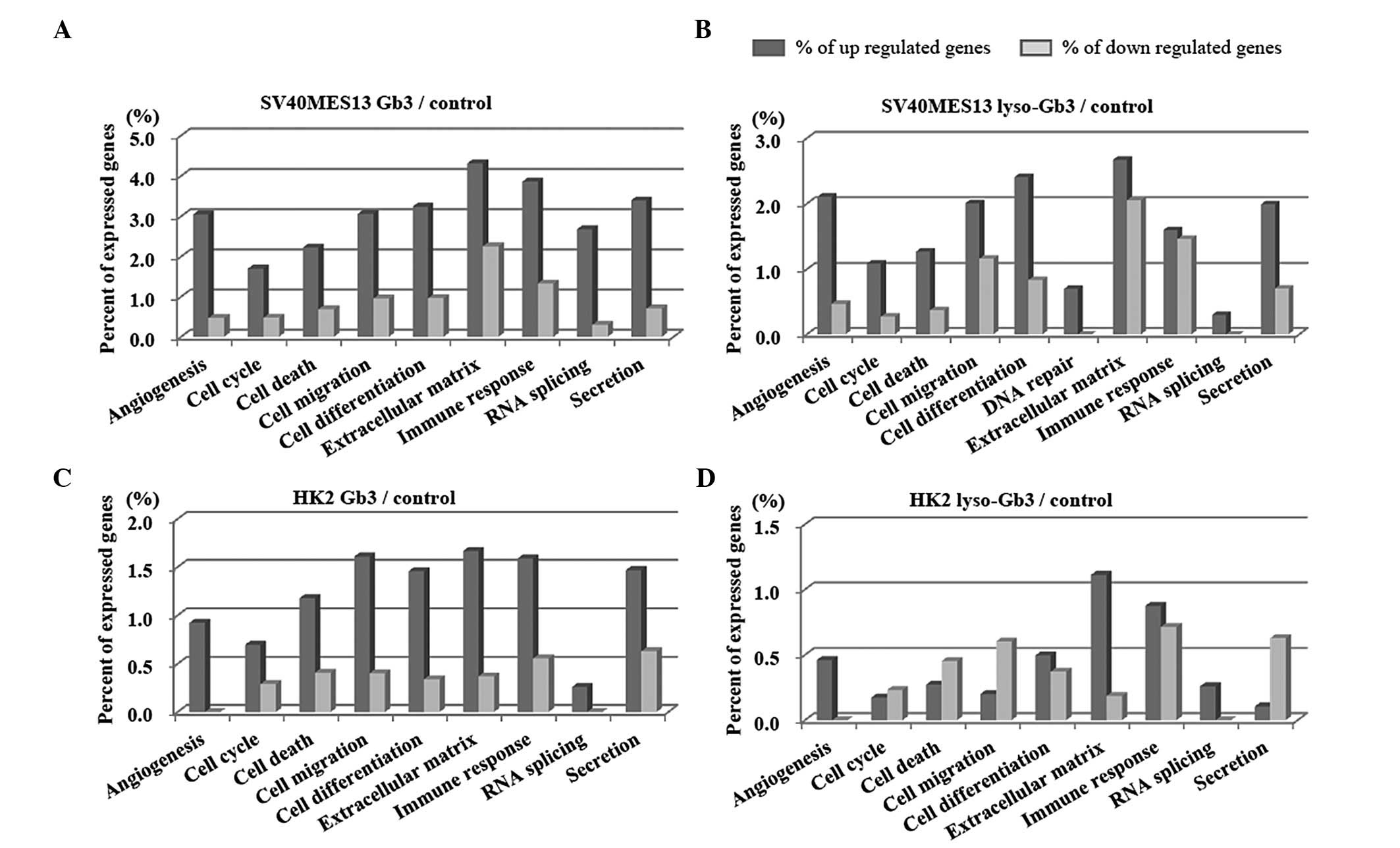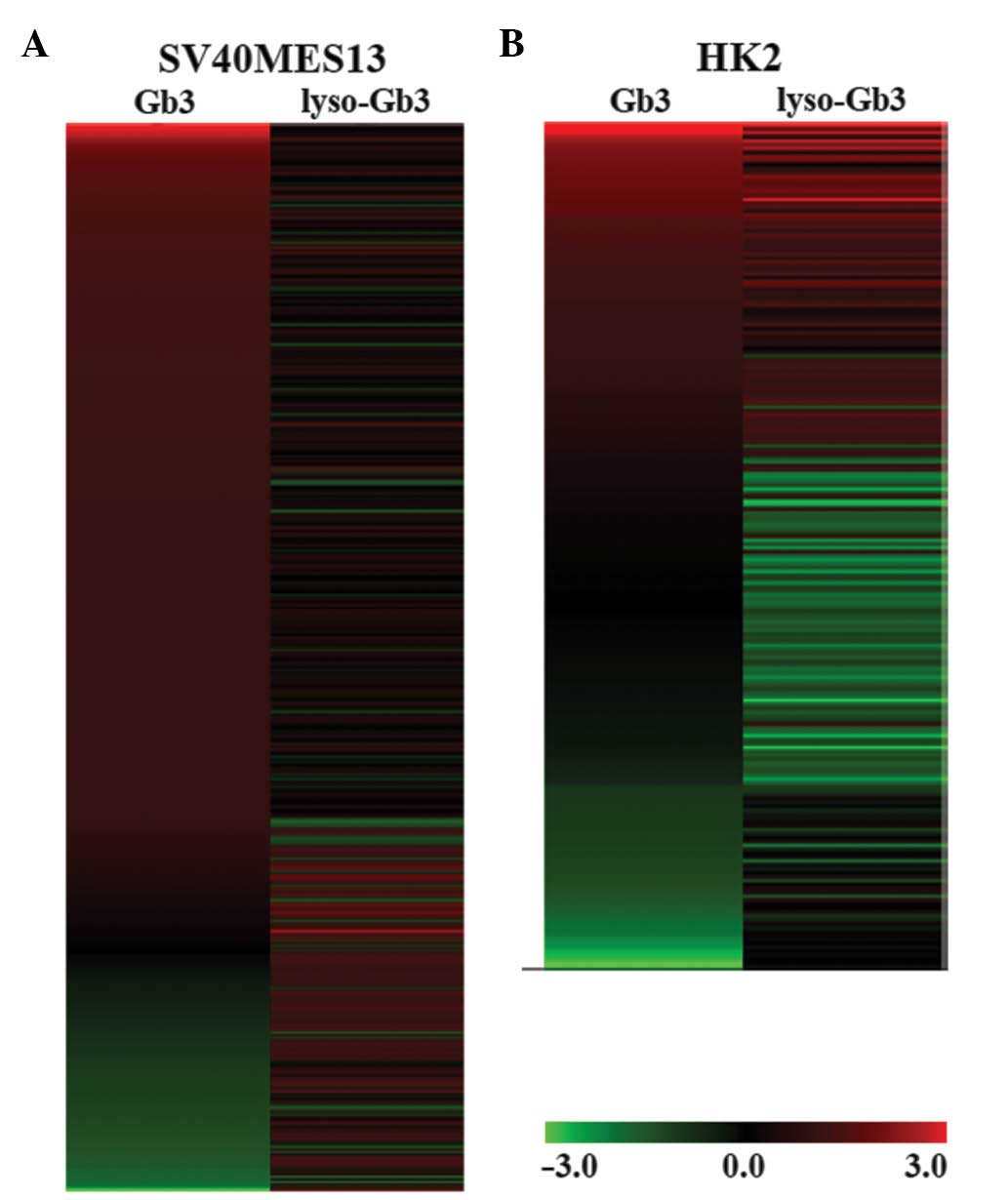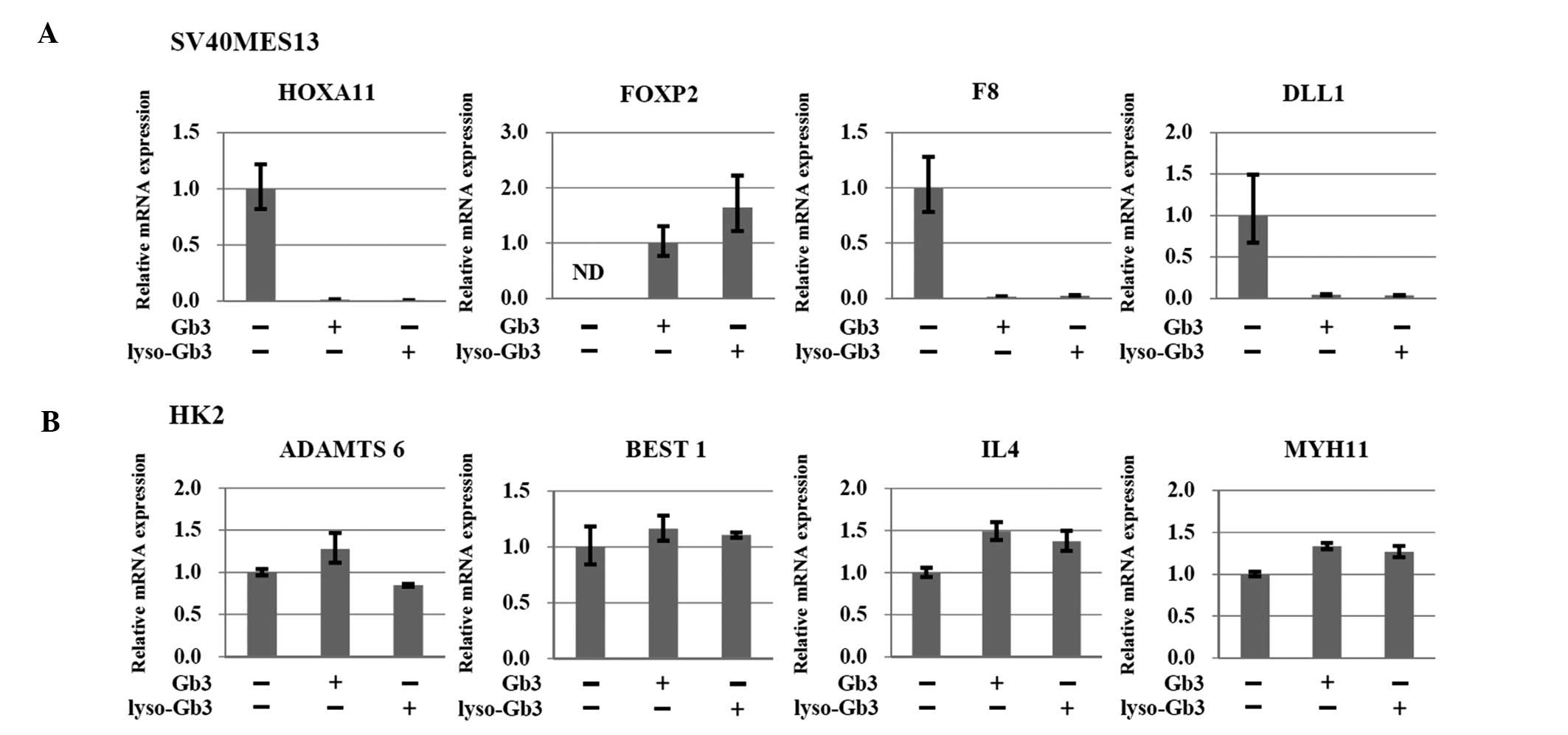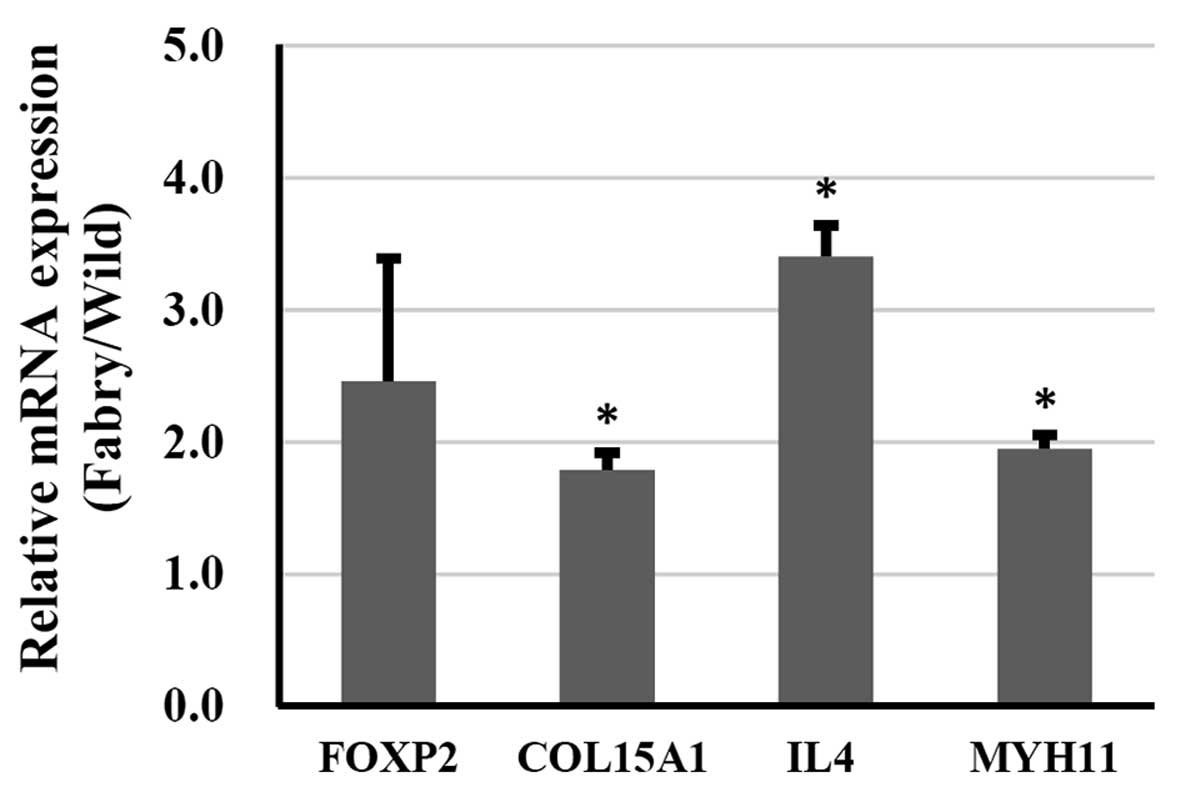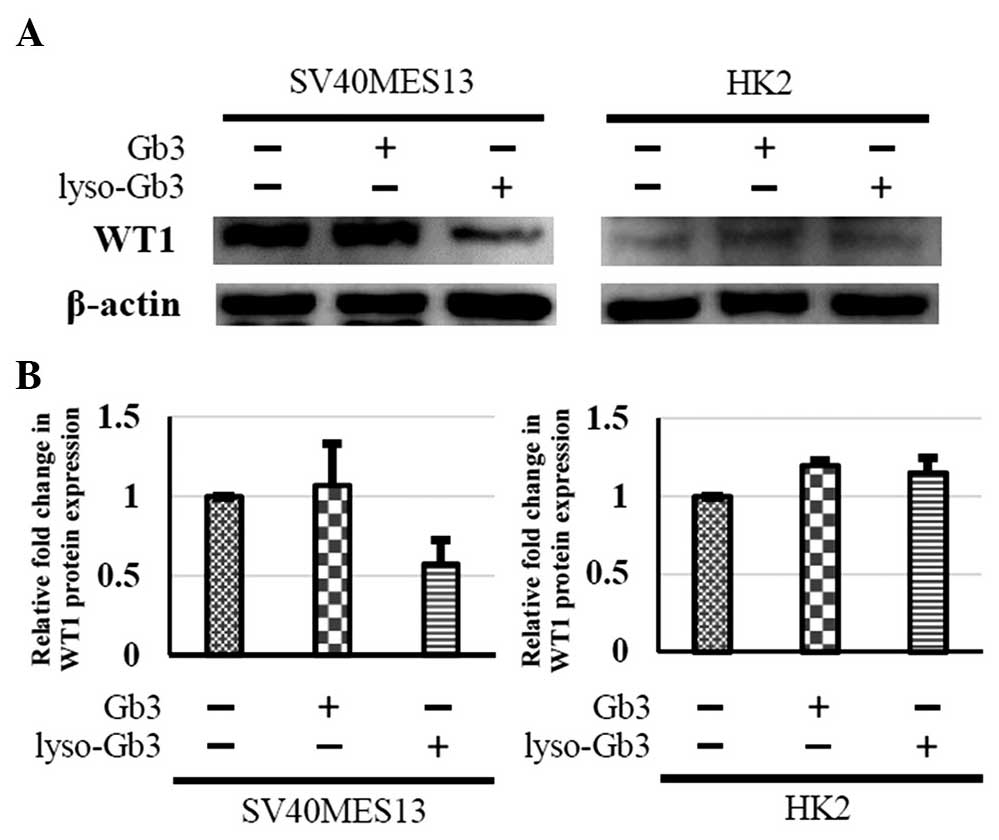|
1
|
Brady RO, Gal AE, Bradley RM, Martensson
E, Warshaw AL and Laster L: Enzymatic defect in Fabry's disease.
Ceramidetrihexosidase deficiency. N Engl J Med. 276:1163–1167.
1967. View Article : Google Scholar : PubMed/NCBI
|
|
2
|
Kint JA: The enzyme defect in Fabry's
disease. Nature. 227:11731970. View Article : Google Scholar : PubMed/NCBI
|
|
3
|
Densick RJ, Ioannou YA and Eng CM:
Alpha-galactosidase A deficiency: Fabry disease. The Metabolic and
Molecular Bases of Inherited Disease. 8th ed. Scriver CR, Beaudet
AL, Sly WS and Valle D: McGraw-Hill; New York: pp. 3733–3774.
2001
|
|
4
|
Weidemann F, Sanchez-Niño MD, Politei J,
Oliveira JP, Wanner C, Warnock DG and Ortiz A: Fibrosis: A key
feature of Fabry disease with potential therapeutic implications.
Orphanet J Rare Dis. 8:1162013. View Article : Google Scholar : PubMed/NCBI
|
|
5
|
Aerts JM, Groener JE, Kuiper S,
Donker-Koopman WE, Strijland A, Ottenhoff R, van Roomen C, Mirzaian
M, Wijburg FA, Linthorst GE, et al: Elevated
globotriaosylsphingosine is a hallmark of Fabry disease. Proc Natl
Acad Sci USA. 105:2812–2817. 2008. View Article : Google Scholar : PubMed/NCBI
|
|
6
|
Sanchez-Niño MD, Sanz AB, Carrasco S,
Saleem MA, Mathieson PW, Valdivielso JM, Ruiz-Ortega M, Egido J and
Ortiz A: Globotriaosylsphingosine actions on human glomerular
podocytes: Implications for Fabry nephropathy. Nephrol Dial
Transplant. 26:1797–1802. 2011. View Article : Google Scholar
|
|
7
|
Campanholle G, Ligresti G, Gharib SA and
Duffield JS: Cellular mechanisms of tissue fibrosis. 3. Novel
mechanisms of kidney fibrosis. Am J Physiol Cell Physiol.
304:C591–C603. 2013. View Article : Google Scholar : PubMed/NCBI
|
|
8
|
Iredale JP: Models of liver fibrosis:
Exploring the dynamic nature of inflammation and repair in a solid
organ. J Clin Invest. 117:539–548. 2007. View Article : Google Scholar : PubMed/NCBI
|
|
9
|
Zeisberg M and Neilson EG: Mechanisms of
tubulointerstitial fibrosis. J Am Soc Nephrol. 21:1819–1834. 2010.
View Article : Google Scholar : PubMed/NCBI
|
|
10
|
Iwano M, Plieth D, Danoff TM, Xue C, Okada
H and Neilson EG: Evidence that fibroblasts derive from epithelium
during tissue fibrosis. J Clin Invest. 110:341–350. 2002.
View Article : Google Scholar : PubMed/NCBI
|
|
11
|
Zeisberg EM, Potenta SE, Sugimoto H,
Zeisberg M and Kalluri R: Fibroblasts in kidney fibrosis emerge via
endothelial-to-mesenchymal transition. J Am Soc Nephrol.
19:2282–2287. 2008. View Article : Google Scholar : PubMed/NCBI
|
|
12
|
Ohshima T, Murray GJ, Swaim WD,
Longenecker G, Quirk JM, Cardarelli CO, Sugimoto Y, Pastan I,
Gottesman MM, Brady RO, et al: α-Galactosidase A deficient mice: a
model of Fabry disease. Proc. Natl Acad Sci USA. 94:2540–2544.
1997. View Article : Google Scholar
|
|
13
|
National Research Council (US) Committee
for the Update of the Guide for the Care and Use of Laboratory
Animals: Guide for the Care and Use of Laboratory Animals. 8th
edition. Washington (DC): National Academies Press (US); 2011
|
|
14
|
Schefe JH, Lehmann KE, Buschmann IR, Unger
T and Funke-Kaiser H: Quantitative real-time RT-PCR data analysis:
Current concepts and the novel “gene expression's CT difference”
formula. J Mol Med. 84:901–910. 2006. View Article : Google Scholar
|
|
15
|
Gubler MC, Lenoir G, Grünfeld JP, Ulmann
A, Droz D and Habib R: Early renal changes in hemizygous and
heterozygous patients with Fabry's disease. Kidney Int. 13:223–235.
1978. View Article : Google Scholar : PubMed/NCBI
|
|
16
|
Fogo AB, Bostad L, Svarstad E, Cook WJ,
Moll S, Barbey F, Geldenhuys L, West M, Ferluga D, Vujkovac B, et
al: Scoring system for renal pathology in Fabry disease: report of
the International Study Group of Fabry Nephropathy (ISGFN). Nephrol
Dial Transplant. 25:2168–2177. 2010. View Article : Google Scholar :
|
|
17
|
Konopka G, Bomar JM, Winden K, Coppola G,
Jonsson ZO, Gao F, Peng S, Preuss TM, Wohlschlegel JA and Geschwind
DH: Human-specific transcriptional regulation of CNS development
genes by FOXP2. Nature. 462:213–217. 2009. View Article : Google Scholar : PubMed/NCBI
|
|
18
|
Hägg PM, Hägg PO, Peltonen S,
Autio-Harmainen H and Pihlajaniemi T: Location of type XV collagen
in human tissues and its accumulation in the interstitial matrix of
the fibrotic kidney. Am J Pathol. 150:2075–2086. 1997.PubMed/NCBI
|
|
19
|
Furusu A, Miyazaki M, Koji T, Abe K, Ozono
Y, Harada T, Nakane PK, Hara K and Kohno S: Involvement of IL-4 in
human glomerulonephritis: an in situ hybridization study of IL-4
mRNA and IL-4 receptor mRNA. J Am Soc Nephrol. 8:730–741.
1997.PubMed/NCBI
|
|
20
|
Rüger BM, Hasan Q, Erb KJ and Davis PF:
Progression of renal disease in interleukin-4 transgenic mice:
involvement of transforming growth factor-beta. Int J Exp Pathol.
80:113–123. 1999. View Article : Google Scholar : PubMed/NCBI
|
|
21
|
Renard M, Callewaert B, Baetens M, Campens
L, MacDermot K, Fryns JP, Bonduelle M, Dietz HC, Gaspar IM, Cavaco
D, et al: Novel MYH11 and ACTA2 mutations reveal a role for
enhanced TGFβ signaling in FTAAD. Int J Cardiol. 165:314–321. 2011.
View Article : Google Scholar
|
|
22
|
Pritchard-Jones K, Fleming S, Davidson D,
Bickmore W, Porteous D, Gosden C, Bard J, Buckler A, Pelletier J
and Housman D: The candidate Wilms' tumour gene is involved in
genitourinary development. Nature. 346:194–197. 1990. View Article : Google Scholar : PubMed/NCBI
|
|
23
|
Buckler AJ, Pelletier J, Haber DA, Glaser
T and Housman DE: Isolation, characterization and expression of the
murine Wilms' tumor gene (WT1) during kidney development. Mol Cell
Biol. 11:1707–1712. 1991.PubMed/NCBI
|
|
24
|
Grubb GR, Yun K, Williams BR, Eccles MR
and Reeve AE: Expression of WT1 protein in fetal kidneys and Wilms
tumors. Lab Invest. 71:472–479. 1994.PubMed/NCBI
|
|
25
|
Brunskill EW and Potter SS: Changes in the
gene expression programs of renal mesangial cells during diabetic
nephropathy. BMC Nephrol. 13:702012. View Article : Google Scholar : PubMed/NCBI
|
|
26
|
Mrowka C and Schedl A: Wilms' tumor
suppressor gene WT1: from structure to renal pathophysiologic
features. J Am Soc Nephrol. 11(Suppl 16): S106–S115.
2000.PubMed/NCBI
|
|
27
|
Hills CE and Squires PE: The role of TGF-β
and epithelial-to mesenchymal transition in diabetic nephropathy.
Cytokine Growth Factor Rev. 22:131–139. 2011.PubMed/NCBI
|



